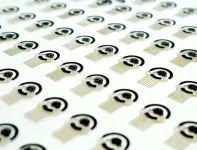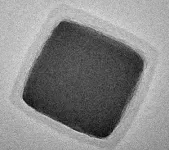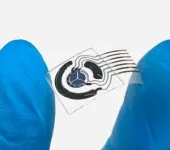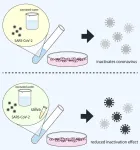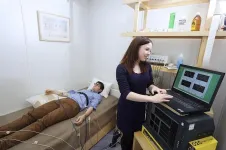(Press-News.org) The future of medicine may very well lie in the personalization of health care—knowing exactly what an individual needs and then delivering just the right mix of nutrients, metabolites, and medications, if necessary, to stabilize and improve their condition. To make this possible, physicians first need a way to continuously measure and monitor certain biomarkers of health.
To that end, a team of Caltech engineers has developed a technique for inkjet printing arrays of special nanoparticles that enables the mass production of long-lasting wearable sweat sensors. These sensors could be used to monitor a variety of biomarkers, such as vitamins, hormones, metabolites, and medications, in real time, providing patients and their physicians with the ability to continually follow changes in the levels of those molecules.
Wearable biosensors that incorporate the new nanoparticles have been successfully used to monitor metabolites in patients suffering from long COVID and the levels of chemotherapy drugs in cancer patients at City of Hope in Duarte, California.
"These are just two examples of what is possible," says Wei Gao, a professor of medical engineering in the Andrew and Peggy Cherng Department of Medical Engineering at Caltech. "There are many chronic conditions and their biomarkers that these sensors now give us the possibility to monitor continuously and noninvasively," says Gao, who is the corresponding author on a paper in the journal Nature Materials describing the new technique.
Gao and his team describe the nanoparticles as core–shell cubic nanoparticles. The cubes are formed in a solution that includes the molecule that the researchers want to track—for example, vitamin C. As the monomers spontaneously assemble to form a polymer, the target molecule—vitamin C—is trapped inside the cubic nanoparticles. Next, a solvent is used to specifically remove the vitamin C molecules, leaving behind a molecularly imprinted polymer shell dotted with holes that have shapes exactly matching that of the vitamin C molecules—akin to artificial antibodies that selectively recognize the shapes of only particular molecules.
Importantly, in the new study, the researchers combine those specially formed polymers with a nanoparticle core made of nickel hexacyanoferrate (NiHCF). This material can be oxidized or reduced under an applied electrical voltage when in contact with human sweat or other bodily fluids. Returning to the vitamin C example, fluid will come into contact with the NiHCF core as long as the vitamin C–shaped holes are unoccupied, and this will generate an electrical signal.
When vitamin C molecules come into contact with the polymer, however, they slip into those holes, thus preventing sweat or other bodily fluids from making contact with the core. This weakens the electrical signal. The strength of the electrical signal, then, reveals just how much vitamin C is present.
"This core is critical. The nickel hexacyanoferrate core is highly stable, even in biological fluids, making these sensors ideal for long-term measurement," says Gao, who is also a Heritage Medical Research Institute Investigator and a Ronald and JoAnne Willens Scholar.
The new core-shell nanoparticles are highly versatile and are used in printing sensor arrays that measure levels of multiple amino acids, metabolites, hormones, or drugs in sweat or bodily fluids simply by using multiple nanoparticle "inks" in a single array. For example, in the work described in the paper, the researchers printed out nanoparticles that bind to vitamin C along with other nanoparticles that bind to the amino acid tryptophan and creatinine, a biomarker commonly measured to see how well the kidneys are working. All of the nanoparticles were combined into one sensor that was then mass produced. These three molecules are of interest in studies of patients with long COVID.
Similarly, the researchers printed out nanoparticles-based wearable sensors that were specific to three different antitumor drugs on individual sensors that were then tested on cancer patients at City of Hope.
"Demonstrating the potential of this technology, we were able to remotely monitor the amount of cancer drugs in the body at any given time," Gao says. "This is pointing the way to the goal of dose personalization not only for cancer but for many other conditions as well."
In the paper, the team also showed that the nanoparticles can be used to print sensors that can be implanted just below the skin to precisely monitor drug levels in the body.
The lead authors of the paper, "Printable molecule-selective core–shell nanoparticles for wearable and implantable sensing" are Minqiang Wang and Cui Ye of Caltech. Additional authors are Yiran Yang (PhD '23), Daniel Mukasa (MS '21), Canran Wang (MS '23), Changhao Xu (PhD '24), Jihong Min (PhD '24), Samuel A. Solomon (MS '23), Jiaobing Tu (PhD '24), and Songsong Tang of Caltech; Guofang Shen and Jeannine S. McCune of the Beckman Research Institute at City of Hope; and Tzung K. Hsiai and Zhaoping Li of the David Geffen School of Medicine at UCLA. The work was supported by funding from the National Science Foundation, the National Institutes of Health, the American Cancer Society, the Office of Naval Research, the Army Research Office, a NASA Cooperative Agreement, the Heritage Medical Research Institute, and the Caltech-City of Hope Biomedical Initiative. The Kavli Nanoscience Institute at Caltech provided critical support and infrastructure for this project.
END
Printable molecule-selective nanoparticles enable mass production of wearable biosensors
2025-02-03
ELSE PRESS RELEASES FROM THIS DATE:
Mapping the yerba mate genome reveals surprising facts about the evolution of caffeine
2025-02-03
Yerba mate, along with tea and coffee, is one of the world’s most popular caffeinated beverages. Widely consumed in South America, this remarkable plant is rich in diverse, bioactive compounds that contribute many health benefits.
An international group of researchers has mapped the yerba mate genome, providing insights into the biosynthesis of caffeine in yerba mate. This new information provides opportunities for creating plant varieties with new characteristics.
The work, led by the ...
Electricity prices across Europe to stabilise if 2030 targets for renewable energy are met, study suggests
2025-02-03
Hitting the current national 2030 quotas for solar and wind energy could reduce the volatility of electricity markets by an average of 20% across 29 European countries, according to a new study from the University of Cambridge.
The intensity of spikes in power prices are predicted to fall in every country by the end of the decade if commitments to green energy are met, as natural gas dependency is cut.
The UK and Ireland would be the biggest beneficiaries, with 44% and 43% reductions in the severity of electricity price spikes by 2030, compared with last year.
Germany could experience a 31% decline in electricity price ...
Improved treatment timing reduces honey bee losses to Varroa mites
2025-02-03
Honey bee mortality can be significantly reduced by ensuring that treatments for the parasitic Varroa mite occur within specific timeframes, a new study reveals.
The mites—belonging to the species Varroa destructor—feed on the larvae of bees and can destroy colonies if not treated at key points to reduce or remove infestations.
But researchers have found that more than a third of beekeepers surveyed in England and Wales deviate from recommended treatment guidelines, including application windows.
Crucially, they found that beekeepers who mistimed Varroa mite treatments experienced exacerbated colony losses, with the effect occurring ...
CAR-T cells can arm bystander T cells with CAR molecules via trogocytosis
2025-02-03
Engineered immune cells called CAR-T cells are used in the treatment of cancer. Researchers from Uppsala University have now discovered that CAR molecules can be transferred from the CAR-T cells to other T cells in the tumour microenvironment. The researchers also pinpoint how this transfer is regulated, which may be used to improve the efficacy of CAR-T cell therapy. The study has been published in the journal Science Immunology.
Immune cells have a capacity to exchange cell surface molecules between one another. This exchange is called trogocytosis and may potentially impact the immune response since it allows different proteins to be transferred between cells.
Chimeric antigen ...
Can ocean-floor mining oversights help us regulate space debris and mining on the Moon?
2025-02-03
by Nishith Mishra, Martina Elia Vitoloni, and Dr Joseph Pelton
Mining ocean resources needed for electric cars and other devices is currently a hot issue of dispute. Final resolution of how or whether the seabed should be expl18oited is pending. Outcomes in this contentious area could create precedents that could impact decisions about mining the moon.
These precedents might shape the how and why of mining the Moon and shape the future and the sustainability of space activities of human beings. But this is only one possible precedent that could reshape the future of space.
Pending international discussions on space traffic management, space debris removal, and limiting ...
Observing ozonated water’s effectiveness against SARS-CoV-2 in saliva
2025-02-03
Disinfecting surfaces is crucial in keeping bacteria and viruses at bay, but the cleaning solutions could be ineffective if met with neutralizing compounds.
Ozonated water has a strong disinfection effect on mold and bacteria, and is also shown to work on SARS-CoV-2, which is responsible for COVID-19. The downside is that ozonated water breaks down quickly in the presence of organic matter, which reduces its effectiveness. SARS-CoV-2 is transmitted through droplets mixed with bodily fluids, such as saliva and nasal mucus which contain organic matters. For this reason, it is necessary to investigate how effective ozonated water is in the presence of ...
Alcohol-related deaths up 18% during pandemic
2025-02-03
Alcohol-related deaths increased 18% during the pandemic, as did hospitalizations related to alcohol use, according to new research in CMAJ (Canadian Medical Association Journal) https://www.cmaj.ca/lookup/doi/10.1503/cmaj.241146.
In the early part of the pandemic, retail alcohol sales volume in Canada increased by 2% (2020/21 v. 2019), the highest increase in 10 years, despite few international visitors. More than 1 in 4 people (26%) reported drinking more, and 18% reported heavy drinking (defined as ...
Mothers of twins face a higher risk of heart disease in the year after birth
2025-02-03
The risk of being admitted to the hospital with heart disease is twice as high the year after birth for mothers of twins compared to singleton births, according to research published in the European Heart Journal [1] today (Monday). The risk is even higher in mothers of twins who had a high blood pressure condition during pregnancy.
The research was led by Professor Cande Ananth from the Department of obstetrics, gynecology, and reproductive sciences at Rutgers Robert Wood Johnson Medical School, New Jersey, USA.
He said: “The rate of twin pregnancies worldwide ...
A new approach to detecting Alzheimer’s disease
2025-02-03
Research led by Lancaster University has revealed clear evidence that changes in the orchestration of brain oxygenation dynamics and neuronal function in Alzheimer’s disease contribute to the neurodegeneration.
The study “Neurovascular phase coherence is altered in Alzheimer’s Disease” is published in Brain Communications. The lead author is Aneta Stefanovska with Juliane Bjerkan, Gemma Lancaster, Peter McClintock and Trevor Crawford from Lancaster University and Bernard Meglič and Jan Kobal from the University of Ljubljana Medical Centre in Slovenia.
Professor Stefanovska said: “Alzheimer's can be hypothesised as being a result ...
Could the contraceptive pill reduce risk of ovarian cancer?
2025-02-02
It’s a little pill with big responsibilities. But despite its primary role to prevent pregnancy, the contraceptive pill (or ‘the Pill’) could also help reduce the risk of ovarian cancer, according to new research from the University of South Australia.
Screening for risk factors of ovarian cancer using artificial intelligence, UniSA researchers found that the oral contraceptive pill reduced the risk of ovarian cancer by 26% among women who had ever used the Pill, and by 43% for women who had used the Pill after the age of 45.
The study also identified some biomarkers associated with ovarian cancer risk, including several characteristics of red blood ...
